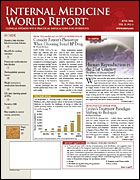Publication
Article
Internal Medicine World Report
Gatifloxacin Linked to Life-Threatening Dysglycemia in the Elderly
Author(s):
N Engl J Med
Fluoroquinolones have become the most commonly prescribed antibiotics, based in part on what has been thought to be their benign side-effect profile. Results of a new study (. 2006;354:1352-1361) support the already available preliminary data that indicated that outpatient gatifloxacin (Tequin) therapy carries the potential for serious hypoglycemic and hyperglycemic episodes.
An examination of the medical records of >1.4 million Canadians aged ≥66 years yielded 788 patients who required treatment for hypoglycemia and 470 patients who required treatment for hyperglycemia within 30 days after an antibiotic course. Investigators conducted 2 population-based, nested case-control studies to determine if the dysglycemia was associated with individual antibiotics.
Hypoglycemia requiring an emergency department visit or hospitalization was >4 times more likely in patients treated with gatifloxacin than in those treated with a macrolide. Of the other fluoroquinolones, only levofloxacin was associated with hypoglycemia, but the increase in risk was only 1.5-fold. Macrolides and second-generation cephalosporins did not increase hypoglycemia risk (Table).
Compared with the macrolides, gatifloxacin was also associated with an almost 17-fold greater risk for hyperglycemia. None of the patients taking other antibiotics developed hyperglycemia requiring treatment.
Speculating that coexistent diabetes could well be skewing these results, the investigators conducted additional analysis, which revealed similarly increased risks regardless of diabetes status. In patients with diabetes, gatifloxacin conferred a 4.2 greater risk of hypoglycemia and a 23.6 greater risk of hyperglycemia. The corresponding increases in risk for patients without diabetes were 9.0 and 12.8.
The investigators noted the following clinical implications:
• Be aware of potentially life-threatening dysglycemia during gatifloxacin therapy
• Tell patients taking gatifloxacin to seek medical help if they develop symptoms of hyperglycemia or hypoglycemia
• Consider prescribing other antibiotics that are as effective as gatifloxacin but have not been associated with glucose abnormalities.
This last point was echoed in an editorial published in the same issue (pages 1413-1415) by Jerry H. Gurwitz, MD, from the Meyers Primary Care Institute in Worcester, Mass. He writes, “For every approved indication for gatifloxacin, there are safer, equally effective, and less costly alternatives.”
Dr Gurwitz concludes that “In comparison with other recent experiences regarding adverse drug effects, this choice should not be a difficult one for physicians, patients, regulators, and manufacturers.”
KEY POINTS
22 million fluoroquinolone prescriptions are written each year.
Gatifloxacin has now been associated with the risk of serious hypoglycemia and hyperglycemia in elderly patients.
The risk for dysglycemia was independent of diabetes status. In elderly patients and in those with diabetes, prescribe other antibiotics, including other fluoroquinolones, that are as effective as gatifloxacin.





